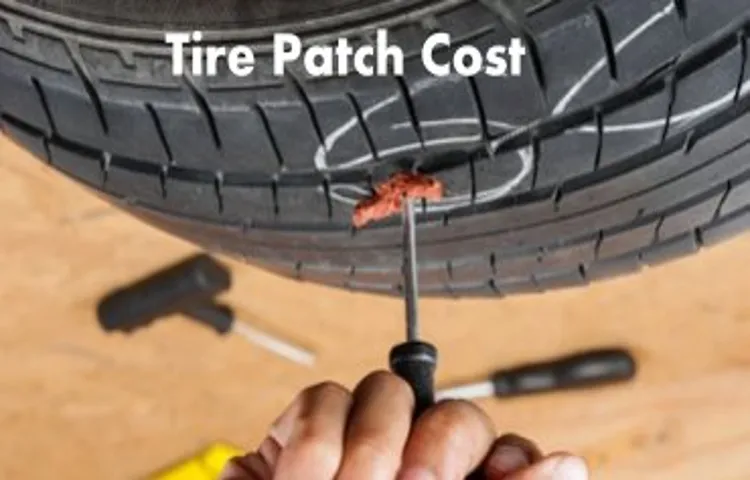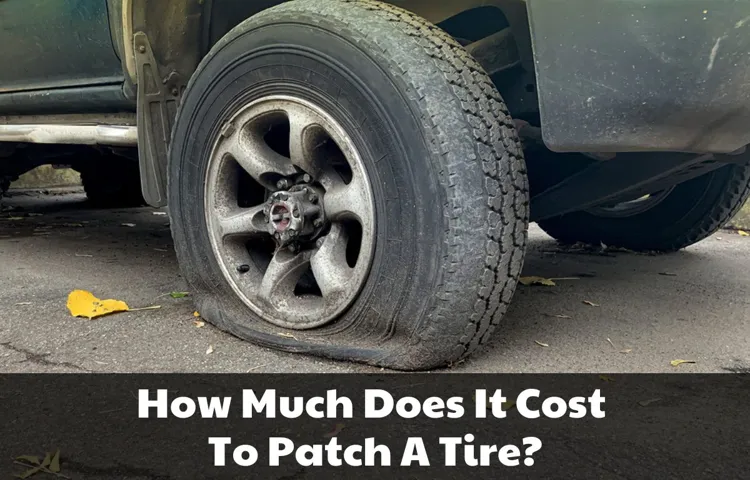Have you ever been driving along and suddenly notice that your tire is going flat? It’s an inconvenience that nobody wants to deal with, but it’s a reality of being a car owner. The good news is that a flat tire can often be patched instead of replaced, saving you money in the long run. But what is the cost of patching a tire, and what do you need to know before bringing your car in for repairs? First and foremost, it’s important to understand that the cost of patching a tire will vary depending on the extent of the damage.
If the puncture is in the tread area and is small enough, it can usually be patched for around $20 to $30. However, if the damage is more severe or located on the sidewall, the tire may need to be replaced entirely, which is obviously a more costly affair. Another factor that can impact the cost of patching a tire is where you take it to be repaired.
If you go to a national chain of tire stores, you may be charged a higher price than if you take your car to a small, local mechanic. It’s worth doing some research and shopping around before deciding where to take your car to be repaired. Overall, while the cost of patching a tire can be an inconvenience, it’s often a much cheaper option than buying a whole new tire.
If you’re unsure whether your tire can be patched, it’s always best to take it to a professional and have them assess the damage. With some careful consideration and a little bit of research, you can save yourself some money and get back on the road in no time.
Table of Contents
Factors That Influence the Cost
If you’re wondering how much it costs to patch a tire, the answer can vary based on several factors. Firstly, the type of tire and its size can affect the cost. Larger and higher-performance tires tend to be more expensive to repair.
Secondly, the severity of the damage will also play a role in pricing. If the puncture is small and located in the tread, it can usually be repaired for a lower cost. However, if the damage is extensive or located in the sidewall, a new tire may need to be purchased, which can be more pricey.
Another factor that can contribute to the cost of tire patching is your location and the availability of tire repair shops in your area. Lastly, your chosen repair shop can also influence the price. Some shops may charge more for their services than others.
In general, it’s important to shop around and compare prices before making a final decision. Overall, the cost of patching a tire can range from $20 to $80 depending on the variables mentioned above.
Type of Tire
When determining the cost of a tire, one of the biggest factors is the type of tire needed for your vehicle. There are several different types of tires, each designed for specific purposes and conditions. For example, if you live in an area with heavy snowfall, you may need snow tires, which have more traction in snowy conditions.
If you do a lot of off-road driving, you may need all-terrain tires, which have deeper treads and better grip. The cost of each type of tire depends on the materials used, the manufacturing process, and the technology used to improve performance. Additionally, high-performance tires designed for sports cars will typically cost more than standard tires.
Keep in mind that while a cheaper tire may seem like a good deal upfront, it may not be as durable or provide the same level of safety as a higher-priced option. So, consider all factors when choosing a tire that fits both your budget and your specific driving needs.

Location of the Damage
When it comes to determining the cost of repairing your vehicle, the location of the damage is a crucial factor. Certain areas are more complex and difficult to repair, which can increase the overall cost. For example, if the damage is located on a panel that has intricate curves and shapes, it may take longer to repair and require more specialized equipment.
Additionally, the location of the damage can also impact how visible the repair is once it’s completed. If the damage is on a prominent area like the hood or doors, it’s often important to ensure the repair is seamless to maintain the value and appearance of the vehicle. Overall, the location of the damage plays a significant role in estimating repair costs, as it affects both the difficulty of the repair and the final appearance of the vehicle.
So, if you’re looking to minimize the cost of repairs, keep in mind that damage located in complex or visible areas may come with a higher price tag.
Severity of the Damage
When dealing with water damage, the severity of the damage is one of the most significant factors that influence the cost of restoration. A minor leak or a small spill would cost less to fix than a massive flood that affects several rooms or the entire structure. The level of damage can also depend on the type of water involved, as clean water is easier to clean up than contaminated or black water.
Furthermore, the time the water has been present can impact the damage level and the restoration costs. The longer it is left unaddressed, the greater the harm it can cause, resulting in more extensive repairs and higher expenses. In conclusion, when dealing with water damage restoration, it is vital to get professional help as soon as possible to prevent further damage and reduce the cost of repairs and restoration.
Type of Service Provider
When it comes to choosing a type of service provider, there are a variety of factors that can influence the cost. One of the biggest factors is the level of expertise and experience that the provider has. For example, a highly skilled professional with years of experience will typically charge more than a beginner in their field.
Additionally, the location of the service provider can also impact the cost. Depending on the area and market demand, prices can vary greatly. Another important factor is the type of service being provided.
Some services, such as complex medical procedures or legal services, require more time and expertise, leading to higher costs. On the other hand, more routine services like cleaning or landscaping may be more affordable. Lastly, the level of customization required can also impact the cost.
Customized services or products that require individual attention may come with higher pricing. In summary, the cost of a service provider can be influenced by expertise level, location, type of service, and level of customization required. It is important to weigh all of these factors before choosing a service provider.
Average Cost of Tire Patching
If you’ve ever had a flat tire, you know how stressful it can be to get it fixed. One of the most common solutions is tire patching, which can save you money compared to buying a brand new tire. But how much does it cost to patch a tire? Well, the cost can vary depending on a variety of factors, such as where you live, the type of tire you have, and the severity of the damage.
On average, the cost of tire patching can range from $10 to $30 per tire. If the damage is more severe, you may need to replace the tire entirely, which could cost you around $100 to $300 or more depending on the brand and type of tire. It’s always best to consult with a professional mechanic to determine the best course of action for your tire issues and get an accurate estimate of the cost.
In the end, the cost of patching a tire is a small price to pay for the peace of mind and safety it provides.
National Average Cost
National Average Cost If you ever find yourself with a flat tire, fear not, because tire patching can be a quick and affordable solution. The national average cost of tire patching in the United States is around $25 to $30 per tire. However, prices may vary depending on your location and the type of tire you have.
For instance, larger or more specialized tires may cost more to patch. Additionally, if you have a damaged sidewall, the tire may not be repairable and may need to be replaced entirely. It is always best to consult with a professional to properly assess the damage and determine the best course of action.
Overall, tire patching is a cost-effective solution for minor tire damage.
Cost Based on Type of Tire
When it comes to tire patching, the cost can vary depending on the type of tire you have. On average, the cost of patching a tire ranges from $20 to $40. This may seem like a small expense, but it can save you a lot of money in the long run.
If you have a high-performance tire, the cost of patching may be higher due to the materials used. Additionally, if you have a larger tire, such as one used on an SUV or truck, the cost may also be higher. It’s important to keep in mind that patching is only a temporary fix and you may eventually need to replace the tire altogether.
But in the meantime, patching can give you the peace of mind you need to get back on the road safely. So, if you notice a puncture or leak in your tire, don’t hesitate to take it in for a patch. The small cost upfront can save you from having to replace your tire sooner than necessary.
Cost Based on Severity of Damage
When it comes to tire patching, the cost can vary depending on the severity of the damage. In general, the average cost of patching a tire ranges from $20 to $40. However, if the damage is more extensive, such as a puncture in the sidewall or a tear in the tread, the cost can increase significantly.
In these cases, it may be more cost-effective to replace the tire altogether rather than repairing it. It’s important to have a professional assess the damage and provide a recommendation for repair or replacement. Don’t take any chances with a damaged tire, as driving on it can lead to dangerous blowouts or accidents.
Save yourself the hassle and potential danger by getting a damaged tire taken care of promptly.
Benefits of Tire Patching
If you’re wondering how much it costs to patch a tire, the answer varies depending on where you go and the extent of the damage. However, tire patching can be a cost-effective solution for repairing small punctures caused by nails or screws, saving you money in the long run. Besides the financial benefits, tire patching also helps prevent the unnecessary disposal of a tire that otherwise could’ve still been in good condition.
Plus, it’s environmentally responsible to avoid adding to the pile of tires in landfills. Patching a tire can be a quick and easy process, taking anywhere from 30 minutes to a few hours, depending on the complexity of the repair. In summary, tire patching can be a budget-friendly and environmentally-friendly solution to repairing a tire that could otherwise end up being costly and wasteful to replace.
Cost Savings
When it comes to maintaining a vehicle, tire patching is one of the best ways to save money. Instead of having to replace a tire that has a small puncture or tear, a tire patch can be an affordable and effective solution. Not only does this save you from having to purchase a brand-new tire, but it also reduces the amount of waste going into landfills.
Plus, tire patching can be done quickly and easily, meaning you can get back on the road without sacrificing your safety or spending too much money. So, if you’re looking for a way to keep your vehicle in top shape while saving some cash, tire patching may be the perfect solution for you.
Safety
Tire patching is one of the best ways to ensure that your safety is not compromised while driving. It involves repairing the punctured tire by applying a patch over the damaged area. The benefits of tire patching are numerous.
First and foremost, it is a cost-effective solution as compared to buying a new tire. Moreover, it ensures that the tires have an extended life and prevent any mishaps that could occur due to a flat tire on the road. Tire patching allows you to continue driving on the road without any hassle.
It is also an eco-friendly solution as it prevents the disposal of the old tire, which is hazardous for the environment. Therefore, it is essential to check your tires regularly and opt for tire patching whenever you see any signs of damage. Not only will it save you the cost of purchasing a new tire, but it will also help you maintain your safety on the road.
Remember, prevention is better than cure, and tire patching is an excellent way to prevent accidents due to a flat tire.
Environmentally Friendly Option
Tire patching is an environmentally friendly option that can benefit both your wallet and the planet. By repairing a punctured tire instead of replacing it, you can significantly reduce the amount of waste that ends up in landfills. Not only that, but patching a tire is often less expensive than buying a brand new one, saving you money in the long run.
Plus, when you consider the energy and resources required to manufacture and transport new tires, opting to patch your existing ones is a much more sustainable choice. Additionally, extending the lifespan of your tires through patching can also help reduce your carbon footprint by decreasing the need for frequent replacements. So next time you experience a flat, consider patching your tire instead of immediately replacing it – your wallet and the environment will thank you!
How to Get the Best Deal on Tire Patching
If you’re wondering how much it costs to patch a tire, the answer is it depends on where you go and what type of tire you have. Typically, you can expect to pay anywhere from $10 to $40 to have a tire patched. However, the best way to get the best deal on tire patching is by shopping around.
Check with multiple auto shops in your area to get quotes on the cost of patching your tire. Additionally, consider investing in a tire repair kit yourself. These kits can be purchased for under $20 and allow you to patch your own tires at home.
While this option may require a bit more effort on your part, it can ultimately save you money in the long run. Just make sure to follow the instructions carefully to ensure a proper patch. Remember, tire patching is important for maintaining the safety and integrity of your tires.
So, don’t put it off and be sure to seek out the best deal possible.
Shop Around
If you’re in need of a tire patching service, it’s important to shop around and get the best deal possible. Start by doing some online research to compare prices and read reviews from other customers. Don’t just settle for the first auto repair shop that you come across – take the time to look for deals or promotions.
Additionally, consider asking around to get recommendations from friends or family who have had similar services done. When you do find a shop that you like, don’t be afraid to negotiate the price or ask for a discount. Getting your tire patched can be a costly expense, but by taking the time to shop around, you can ensure that you get the best deal possible.
So, be proactive, ask questions and ultimately snag a good deal that suits your budget.
Take Advantage of Discounts
Tire patching may not be the most exciting task, but it’s something that every driver will eventually have to deal with. Luckily, there are ways to get the best deal on this necessary service. One of the easiest ways to save money on tire patching is to take advantage of discounts.
Many tire shops will offer deals throughout the year, particularly during the slow season. If you’re not in a rush and can wait for the right deal, you could end up saving quite a bit of money. Another way to save money is by checking online for coupons or promotions.
Doing a quick search can often lead to surprising discounts. By being mindful of these discounts, you can be sure to get the best deal on tire patching.
Negotiate the Price
When it comes to getting your tire patched, negotiating the price is a key step in getting the best deal. One way to approach this is by researching prices at different tire shops and using that information to negotiate with the shop of your choice. Be upfront and transparent about your budget and the prices you have found elsewhere.
If the shop is unwilling to match or beat a competitor’s price, don’t be afraid to walk away and find a better deal elsewhere. Remember, getting your tire patched is important for your safety on the road, but that doesn’t mean you have to break the bank to do so. By negotiating the price, you can save yourself some money and ensure that you are getting a fair deal.
So go ahead and ask for a discount – the worst they can say is no!
Conclusion
In conclusion, the cost of patching a tire can vary depending on the severity of the damage and the type of tire. Think of it like getting a Band-Aid for a scraped knee – a small nick might only require a simple patch, while a larger hole may need a full-on tire replacement. But one thing’s for sure – investing in a patch now can save you the headache (and wallet ache) of having to replace your entire tire down the line.
So, keep your tires healthy and happy, and they’ll return the favor by getting you where you need to go without a hitch (or a puncture).
FAQs
What is the average cost to patch a tire?
The average cost to patch a tire ranges from $10 to $30 per tire, depending on the location and severity of the damage.
Can a tire be patched for free?
Some tire shops or dealerships may patch a tire for free if you purchased the tire from them or have a warranty. It’s best to call and ask about their policies on tire patching.
How long does it take to patch a tire?
The amount of time it takes to patch a tire can vary, but typically it takes about 15-30 minutes to patch a tire, depending on the severity of the damage and how busy the shop is.
Can any tire be patched or only certain types?
Not all tires can be patched, but most punctures on the tread area of the tire can be patched. However, if the damage is on the sidewall of the tire, it cannot be patched and the tire will need to be replaced.
Is it safe to drive on a patched tire?
Yes, it is generally safe to drive on a properly patched tire. However, it’s important to follow the patching guidelines and manufacturer recommendations to ensure the safety of the tire.
Can I patch a tire more than once?
It’s not recommended to patch a tire more than once, as multiple patches can compromise the tire’s integrity and increase the risk of a blowout.
Can I patch a run-flat tire?
Run-flat tires cannot be patched and must be replaced if they are damaged.



